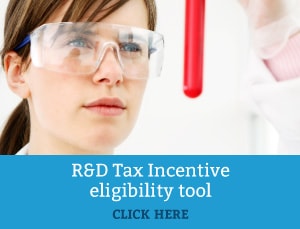Is your Company Eligible for the R&D Tax Incentive?
April 8th, 2016Historically, the R&D tax incentive was formed with a key goal of making government investment for innovation more attainable to small businesses. Innovation, as a whole, impels small business to invest up front in their ideas. However, the aid of a refundable tax offset has helped to considerably alleviate the risk. In fact, the number of companies accessing R&D tax benefits from the Australian government has augmented to beyond 13,000 over the years. Over 7,000 small businesses currently apply for the program, however over 20,000 small businesses are actually eligible to claim. Many small businesses mistakenly believe they do not qualify for the incentive, therefore, we’ve fragmented and clarified the elements of eligibility.
To begin with, you’re like to qualify for the incentive if your business meets the following criteria:
- Incorporated as a company;
- A for-profit entity;
- Registered in Australia;
- Spent between twenty thousand dollars two million dollars on eligible expenses in the last financial year; and,
- You undertook a project to improve an existing or build a new product, process or service.
In contrast, other “non-company” entities are not eligible – this involves trusts, partnerships, cooperatives and sole traders. Hence, highlighting the fact that organisations should be incorporated as an Australian company to be eligible for the R&D Tax Incentive. If your business isn’t incorporated in Australia, it is unlikely that you’re eligible – however, there are some unique circumstances that may still make you eligible. In this instance, it is best to get in contact with a specialist to review the situation in more detail.
Aside from having a company profile that aligns with the eligibility, a company must be engaging in eligible R&D activities. These must then be classified as either core or supporting activities. However, to start off with, a few qualifying questions a startup or small business founder could ask themselves include:
- Am I undertaking something new and dissimilar to what the rest of my market is doing?
- Is this new product/process/software we are building challenging?
- Did we attempt to do something really innovative and fail?
- Did we have to test this product or service?
In essence, if you are a firm who is creating new or improved products or services – and the development involves investing in a degree of experimentation or prototyping (whether it fails or not) – there’s a high likelihood you may be eligible for the R&D tax incentive. Therefore, at the very least, startups and small companies should be enquiring or asking questions about their eligibility. In fact, the R&D Tax Incentive is much more broadly applicable than people realise and is in no way industry-specific.
By capitalising on the opportunities that the R&D tax incentive offers, companies can produce generous tax savings, including generating cash for their past and future investments or developments. In addition, there is no cap on the level of eligible R&D expenditure that a company can claim. Companies with annual turnover of less than $20 million can claim the 43.5% tax offset on all their eligible expenditure. Those with annual turnover of more than $20 million can claim a 38.5% tax offset on all their eligible expenditure. However, to claim a tax offset under the R&D Tax Incentive program, companies must register R&D activities with AusIndustry within 10 months of the end of the income year in which they were undertaken. Hence, for majority of companies with a standard income period of 1 July 2014 to 30 June 2015, lodgement of their registration with AusIndustry is due by 30 April 2016.
As the deadline is the end of this month, it is recommended that businesses check eligibility and seek the advice of an R&D Tax Specialist in order to take advantage of the possible tax benefits.
Categories
- ATO Guidance and Materials
- AusIndustry Guidance and Materials
- Case Law
- Federal Budget 2021
- Federal Budget 2022
- Federal Budget 2024
- For Accountants
- General Information
- Government Policy and Treasury
- Industry Specific Issues
- Interpretative Decisions
- Legislation and Parliamentary Matters
- R&D Tax Credit
- R&D Tax Funding Strategies
- R&D Tax Loans
- Recent News
- Tax Determinations
Archives
- October 2024
- September 2024
- August 2024
- July 2024
- June 2024
- May 2024
- April 2024
- March 2024
- February 2024
- January 2024
- December 2023
- November 2023
- October 2023
- September 2023
- August 2023
- July 2023
- June 2023
- May 2023
- April 2023
- March 2023
- February 2023
- January 2023
- December 2022
- November 2022
- October 2022
- September 2022
- August 2022
- July 2022
- June 2022
- May 2022
- April 2022
- March 2022
- February 2022
- January 2022
- December 2021
- November 2021
- October 2021
- September 2021
- August 2021
- July 2021
- June 2021
- May 2021
- April 2021
- March 2021
- February 2021
- January 2021
- December 2020
- November 2020
- October 2020
- September 2020
- August 2020
- July 2020
- June 2020
- May 2020
- April 2020
- March 2020
- February 2020
- January 2020
- December 2019
- November 2019
- October 2019
- September 2019
- August 2019
- July 2019
- June 2019
- May 2019
- April 2019
- March 2019
- February 2019
- January 2019
- December 2018
- November 2018
- September 2018
- July 2018
- June 2018
- May 2018
- April 2018
- March 2018
- February 2018
- January 2018
- December 2017
- November 2017
- September 2017
- August 2017
- July 2017
- June 2017
- May 2017
- April 2017
- March 2017
- February 2017
- January 2017
- December 2016
- November 2016
- October 2016
- September 2016
- August 2016
- July 2016
- June 2016
- May 2016
- April 2016
- March 2016
- February 2016
- January 2016
- December 2015
- November 2015
- October 2015
- September 2015
- August 2015
- July 2015
- June 2015
- May 2015
- April 2015
- March 2015
- February 2015
- January 2015
- November 2014
- October 2014
- September 2014
- August 2014
- July 2014
- June 2014
- May 2014
- April 2014
- March 2014
- February 2014
- January 2014
- December 2013
- November 2013
- October 2013
- September 2013
- May 2013
- April 2013
- March 2013
- September 2012
- August 2012
- June 2012


 Free Call: 1800 792 676
Free Call: 1800 792 676






 News & Research
News & Research



